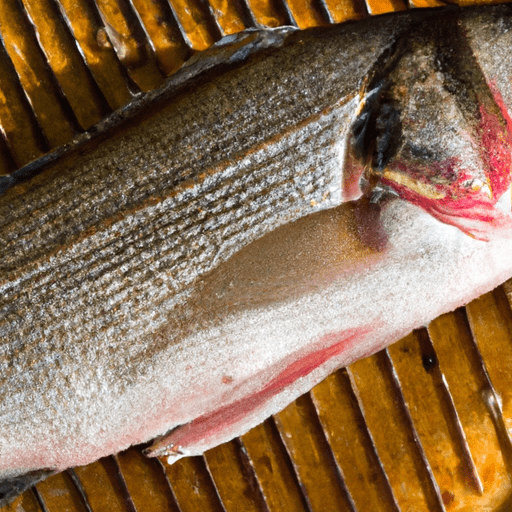Exploring the Delights of Striped Bass: A Culinary Adventure
When it comes to indulging in the treasures of the sea, there is a particular fish that stands out with its unique flavor and versatility in the culinary world - the majestic Striped Bass. With its firm texture, mild but distinctive taste, and rich nutritional profile, it’s no wonder this striped beauty has won the hearts of seafood lovers worldwide.
A Taste of the Sea
The flavor of Striped Bass is often described as sweet and succulent, with a hint of earthiness. This delicate white fish boasts a clean taste that easily absorbs the flavors of various ingredients, making it an ideal choice for numerous cooking styles and preparations. The flesh of the Striped Bass is tender, yet firm, allowing it to hold up well to grilling, baking, frying, and even poaching.
Versatility in the Kitchen
One of the many delights of cooking with Striped Bass is its versatility. Its adaptable nature allows it to be paired with various flavors, making it suitable for both simple and elaborate dishes. Here are a few popular methods of preparation:
Grilled Delight
Grilling Striped Bass showcases its natural flavors and creates a lightly charred exterior. Season it with a sprinkle of sea salt, cracked black pepper, and a drizzle of olive oil, then throw it on a hot grill for a few minutes on each side. The result is a smoky, melt-in-your-mouth fillet that is sure to impress.
Classic Baked Herb
For a classic and foolproof option, bake your Striped Bass with a medley of fresh herbs. Prepare a mixture of chopped parsley, thyme, garlic, and lemon zest. Gently rub this herb mixture onto the fish, then bake it at a moderate temperature until it is cooked through. The aroma that wafts through your kitchen as it bakes will surely whet your appetite.
Pan-Fried Crispy Crust
If you crave a delicate yet crispy texture on the outside, pan-frying your Striped Bass is the way to go. Coat the fish with a light dusting of flour, then carefully pan-fry it in a bit of butter or oil until golden brown. Serve it with a squeeze of fresh lemon juice to add a zesty kick that balances the richness of the fish.
A Nutritional Powerhouse
Beyond its delectable taste, Striped Bass is also a nutritional powerhouse. Packed with essential vitamins and minerals, it offers a range of health benefits. Here are a few reasons why incorporating Striped Bass into your diet is a wise choice:
- Omega-3 Fatty Acids: Striped Bass is an excellent source of omega-3 fatty acids, which promote heart health, reduce inflammation, and support brain function.
- Protein-Rich: Striped Bass provides a high-quality source of protein, which is essential for building and repairing tissues, maintaining strong immune function, and helping to regulate hormones.
- Vitamin B12: This fish is a rich source of vitamin B12, which plays a vital role in energy production, red blood cell formation, and nerve function.
- Selenium: Striped Bass contains selenium, a powerful antioxidant that helps protect cells from damage and supports a healthy immune system.
A Historical Catch
Moving beyond its culinary merits, Striped Bass holds an interesting place in history. Native to the eastern coast of North America, particularly the Atlantic Ocean, this prized fish has played a significant role in the local economy and culture.
In fact, Striped Bass has a fascinating past as it was almost driven to extinction due to overfishing in the early 1980s. However, with the implementation of regulations and conservation efforts, its population rebounded significantly. Today, sustainable fishing practices help ensure its availability while protecting the species in the wild.
Striped Bass deserves a prime spot on every seafood enthusiast’s plate. From its delicate flavor to its culinary versatility and nutritional benefits, this fish continues to captivate the taste buds of those who appreciate the wonders of the sea.
So, why not embark on your own culinary adventure and try your hand at cooking up a delectable striped bass dish? Whether it’s grilling, baking, or pan-frying, let the unique qualities of this incredible fish shine through, creating flavors that will have you coming back for more.
Striped Bass
Origin: The striped bass (Morone saxatilis) is native to the Atlantic coast of North America, ranging from the Gulf of St. Lawrence in Canada to the St. Johns River in Florida, USA.
Common Uses: Striped bass is highly regarded as a flavorful fish and is popular in culinary preparations. It can be cooked by grilling, baking, broiling, or pan-frying. It is often served in fillet form but is also used in various dishes like fish tacos, ceviche, and fish chowder.
Nutritional Benefits: Striped bass is a good source of lean protein, omega-3 fatty acids, vitamin D, and several essential minerals including selenium, phosphorus, and magnesium. Omega-3 fatty acids are beneficial for heart health and may help reduce inflammation.
Unique Properties: Striped bass has black stripes running along its silvery body, giving it its distinctive name. It has a firm texture and a mild, slightly sweet flavor, which makes it versatile for different cooking methods. Its flesh is white when cooked and has a tender yet meaty quality.
Historical Significance: Striped bass has gained historical significance in the U.S. It plays a significant role in commercial and recreational fishing, with recreational striped bass fishing dating back to the late 19th century. Striped bass were once endangered due to overfishing, but successful conservation efforts have helped the population rebound. It is now an important sportfish and continues to be a valued culinary ingredient.




Use the share button below if you liked it.
It makes me smile, when I see it.